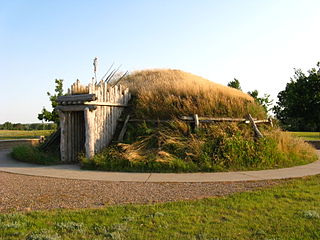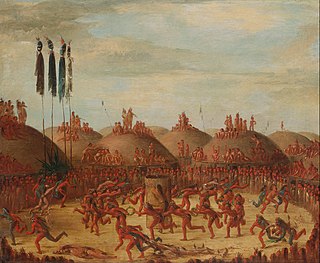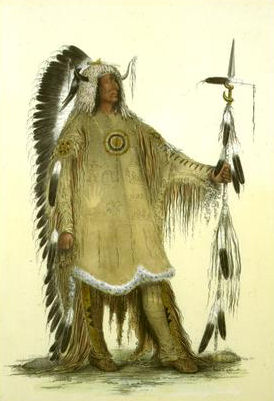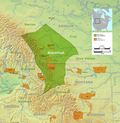Related Research Articles
The Mandan, Hidatsa, and Arikara Nation, also known as the Three Affiliated Tribes, is a Native American Nation resulting from the alliance of the Mandan, Hidatsa, and Arikara peoples, whose native lands ranged across the Missouri River basin extending from present day North Dakota through western Montana and Wyoming.

The Arikara War was a military conflict between the United States and Arikara in 1823 fought in the Great Plains along the Upper Missouri River in the Unorganized Territory. For the United States, the war was the first in which the United States Army was deployed for operations west of the Missouri River on the Great Plains. The war, the first and only conflict between the Arikara and the U.S., came as a response to an Arikara attack on U.S. citizens engaged in the fur trade. The Arikara War was called "the worst disaster in the history of the Western fur trade".

The Hidatsa are a Siouan people. They are enrolled in the federally recognized Three Affiliated Tribes of the Fort Berthold Reservation in North Dakota. Their language is related to that of the Crow, and they are sometimes considered a parent tribe to the modern Crow in Montana.

Arikara, also known as Sahnish, Arikaree, Ree, or Hundi, are a tribe of Native Americans in North Dakota. Today, they are enrolled with the Mandan and the Hidatsa as the federally recognized tribe known as the Mandan, Hidatsa, and Arikara Nation.

The Mandan are a Native American tribe of the Great Plains who have lived for centuries primarily in what is now North Dakota. They are enrolled in the Three Affiliated Tribes of the Fort Berthold Reservation. About half of the Mandan still reside in the area of the reservation; the rest reside around the United States and in Canada.

Population figures for the Indigenous peoples of the Americas prior to European colonization have been difficult to establish. By the end of the 20th century, most scholars gravitated toward an estimate of around 50 million, with some historians arguing for an estimate of 100 million or more.

The Knife River Indian Villages National Historic Site, which was established in 1974, preserves the historic and archaeological remnants of bands of Hidatsa, Northern Plains Indians, in North Dakota. This area was a major trading and agricultural area. Three villages were known to occupy the Knife area. In general, these three villages are known as Hidatsa villages. Broken down, the individual villages are Awatixa Xi'e, Awatixa and Big Hidatsa village. Awatixa Xi'e is believed to be the oldest village of the three. The Big Hidatsa village was established around 1600.

The Hunkpapa are a Native American group, one of the seven council fires of the Lakota tribe. The name Húŋkpapȟa is a Lakota word, meaning "Head of the Circle". By tradition, the Húŋkpapȟa set up their lodges at the entryway to the circle of the Great Council when the Sioux met in convocation. They speak Lakȟóta, one of the three dialects of the Sioux language.

The Crow Creek Indian Reservation, home to Crow Creek Sioux Tribe is located in parts of Buffalo, Hughes, and Hyde counties on the east bank of the Missouri River in central South Dakota in the United States. It has a land area of 421.658 square miles (1,092.09 km2) and a 2000 census population of 2,225 persons. The major town and capital of the federally recognized Crow Creek Sioux Tribe is Fort Thompson.

Like-a-Fishhook Village was a Native American settlement next to Fort Berthold in North Dakota, United States, established by dissident bands of the Three Affiliated Tribes, the Mandan, Arikara and Hidatsa. Formed in 1845, it was also eventually inhabited by non-Indian traders, and became important in the trade between Natives and non-Natives in the region.

Mato-tope was the second chief of the Mandan tribe to be known as "Four Bears," a name he earned after charging the Assiniboine tribe during battle with the strength of four bears. Four Bears lived in the first half of the 19th century on the upper Missouri River in what is now North Dakota. Four Bears was a favorite subject of artists, painted by George Catlin and Karl Bodmer.

Fort Clark Trading Post State Historic Site was once the home to a Mandan and later an Arikara settlement. Over the course of its history it also had two factories. Today only archeological remains survive at the site located eight miles west of Washburn, North Dakota, United States.
The history of smallpox extends into pre-history. Genetic evidence suggests that the smallpox virus emerged 3,000 to 4,000 years ago. Prior to that, similar ancestral viruses circulated, but possibly only in other mammals, and possibly with different symptoms. Only a few written reports dating from about 500 AD to 1000 AD are considered reliable historical descriptions of smallpox, so understanding of the disease prior to that has relied on genetics and archaeology. However, during the 2nd millennium AD, especially starting in the 16th century, reliable written reports become more common. The earliest physical evidence of smallpox is found in the Egyptian mummies of people who died some 3,000 years ago. Smallpox has had a major impact on world history, not least because indigenous populations of regions where smallpox was non-native, such as the Americas and Australia, were rapidly and greatly reduced by smallpox during periods of initial foreign contact, which helped pave the way for conquest and colonization. During the 18th century the disease killed an estimated 400,000 Europeans each year, including five reigning monarchs, and was responsible for a third of all blindness. Between 20 and 60% of all those infected—and over 80% of infected children—died from the disease.
Fort Simpson was a fur trading post established in 1831 by the Hudson's Bay Company (HBC) near the mouth of the Nass River in present-day British Columbia, Canada. In 1834, it was moved to the Tsimpsean Peninsula, about halfway between the Nass River and the Skeena River, and was later referred to as Port Simpson or as the native name Lax Kw'alaams. The fort was part of the HBC's Columbia Department.
Fort Berthold was the name of two successive forts on the upper Missouri River in present-day central-northwest North Dakota. Both were initially established as fur trading posts. The second was adapted as a post for the U.S. Army. After the Army left the area, having subdued Native Americans, the fort was used by the US as the Indian Agency for the regional Arikara, Hidatsa, and Mandan Affiliated Tribes and their reservation.
Although a variety of infectious diseases existed in the Americas in pre-Columbian times, the limited size of the populations, smaller number of domesticated animals with zoonotic diseases, and limited interactions between those populations hampered the transmission of communicable diseases. One notable infectious disease that may be of American origin is syphilis. Aside from that, most of the major infectious diseases known today originated in the Old World. The American era of limited infectious disease ended with the arrival of Europeans in the Americas and the Columbian exchange of microorganisms, including those that cause human diseases. Eurasian infections and epidemics had major effects on Native American life in the colonial period and nineteenth century, especially.
This timeline of South Dakota is a list of events in the history of South Dakota by year.

Ring vaccination is a strategy to inhibit the spread of a disease by vaccinating those who are most likely to be infected.
The Indian Vaccination Act is a US federal law was passed by the US Congress in 1832. The purpose of the act was to vaccinate the American Indians against smallpox to prevent the spread of the disease.
The 1862 Pacific Northwest smallpox epidemic was a smallpox outbreak that started in Victoria on Vancouver Island and spread among the indigenous peoples of the Pacific Northwest Coast and into the indigenous peoples of the Northwest Plateau, killing a large portion of natives from the Puget Sound region to Southeast Alaska. Two-thirds of British Columbia natives died—around 20,000 people. The death rate was highest in southeast Alaska and Haida Gwaii—over 70% among the Haida and 60% among the Tlingit. Almost all native nations along the coast, and many in the interior, were devastated, with a death rate of over 50% for the entire coast from Puget Sound to Sitka, Alaska, part of Russian America at the time. In some areas the native population fell by as much as 90%. The disease was controlled among colonists in 1862 but it continued to spread among natives through 1863.
References
- 1 2 Rationalizing Epidemics: Meanings and Uses of American Indian Mortality Since 1600; David S. Jones; Harvard University Press; 2004; Pg. 76
- 1 2 3 4 5 6 7 8 9 Daschuk, James (2013). Clearing the Plains disease, politics of starvation, and the loss of Aboriginal life. Regina: University of Regina Press. ISBN 9780889772977.
- ↑ "Mandan | History, Traditions, & Facts | Britannica". www.britannica.com. Retrieved 2024-04-26.
- 1 2 3 The Effect of Smallpox on the Destiny of the Amerindian; Esther Wagner Stearn, Allen Edwin Stearn; University of Minnesota; 1945; Pgs. 13-20, 73-94, 97
- ↑ Dollar, Clyde D. (1977). "The High Plains Smallpox Epidemic of 1837-38". The Western Historical Quarterly. 8 (1): 15–38. doi:10.2307/967216. ISSN 0043-3810. JSTOR 967216.
- ↑ Stearn, Esther Wagner; Stearn, Allen Edwin (1945). The Effect of Smallpox on the Destiny of the Amerindian. University of Minnesota. pp. 13–20, 73–94, 97.
- 1 2 3 Daschuk, James (2013). Clearing the Plains disease, politics of starvation, and the loss of Aboriginal life. Regina: University of Regina Press. p. 12. ISBN 9780889772977.
- 1 2 3 4 5 Hackett, F. J. Paul (2004-09-08). "Averting Disaster: The Hudson's Bay Company and Smallpox in Western Canada during the Late Eighteenth and Early Nineteenth Centuries". Bulletin of the History of Medicine. 78 (3): 575–609. doi:10.1353/bhm.2004.0119. ISSN 1086-3176. PMID 15356371. S2CID 2576528.
- ↑ Kohn, George Childs (2007). Encyclopedia of plague & pestilence (3rd ed.). New York: Facts On File. ISBN 978-0816069354.
- ↑ Stearn, Ester Wagner; Stearn, Allen Edwin (1945). The Effect of Smallpox on the Destiny of the Amerindian. University of Minnesota.
- ↑ Lythcott, Donald R. Hopkins (1983). Princes and peasants : smallpox in history. Chicago: Minn. pp. 270–271. ISBN 978-0226351766.
- ↑ Stearn, Ester Wagner; Stearn, Allen Edwin (1945). The Effect of Smallpox on the Destiny of the Amerindian. University of Minnesota. pp. 13–20, 73–94, 97.
- ↑ Ostler, Jeffrey (2004). The Plains Sioux and U.S. colonialism from Lewis and Clark to Wounded Knee. Cambridge: Cambridge University Press. ISBN 9780521605908. OCLC 53951752.
- 1 2 Dollar, Clyde D. (1977-01-01). "The High Plains Smallpox Epidemic of 1837–38". Western Historical Quarterly. 8 (1): 15–38. doi:10.2307/967216. ISSN 0043-3810. JSTOR 967216. PMID 11633561.
- 1 2 Kohn, George C. Encyclopedia of Plague and Pestilence: From Ancient Times to the Present. pp. 252–253.
- 1 2 Calloway, Colin G. (2008). First Peoples: A Documentary History of American History (3rd ed.). Boston: Bedford/St. Martin's. pp. 290–370 (p.297). ISBN 9780312453732.
- ↑ Ray, Arthur J. (1990). The Canadian fur trade in the industrial age . Toronto: University of Toronto Press. ISBN 978-0802067432. OCLC 25373609.
- ↑ Dollar, Clyde D. (1977-01-01). "The High Plains Smallpox Epidemic of 1837–38". Western Historical Quarterly. 8 (1): 15–38. doi:10.2307/967216. ISSN 0043-3810. JSTOR 967216. PMID 11633561.
- ↑ Abel, Annie Heloise (1932). Chardon's Journal at Fort Clark, 1834-1839. Books for Libraries Press. pp. 319, 394.
- 1 2 Peers, Laura (1991). "Changing Resource-Use Patterns of Saulteaux Trading at Fort Pelly, 1821-1879". In Abel, Kerry; Friesen, Jean (eds.). Aboriginal Resource-Use in Canada: Historical and Legal Aspects. Winnipeg: University of Manitoba Press.
- 1 2 3 Robertson, R. G. (2001). Rotting Face: Smallpox and the American Indian . Caxton Press. pp. 80–83, 298–312.
- ↑ Mann, Barbara Alice (2009). The Tainted Gift: The Disease Method of Frontier Expansion. ABC-CLIO. pp. 62–63.
- ↑ Vectors of Death: The Archaeology of European Contact. University of New Mexico Press. 1987. pp. 147–148.
- ↑ "Report of the Investigative Committee of the Standing Committee on Research Misconduct" (PDF). University of Colorado at Boulder. May 9, 2006. pp. 81–82. Archived from the original (PDF) on 2008-01-05.
- ↑ Tope, Mato. "To die with my face rotten". In Blaisdell, Robert (ed.). Great Speeches by Native Americans. p. 116.
- ↑ Thomas Brown, Did the U.S. Army Distribute Smallpox Blankets to Indians? Fabrication and Falsification in Ward Churchill's Genocide Rhetoric
